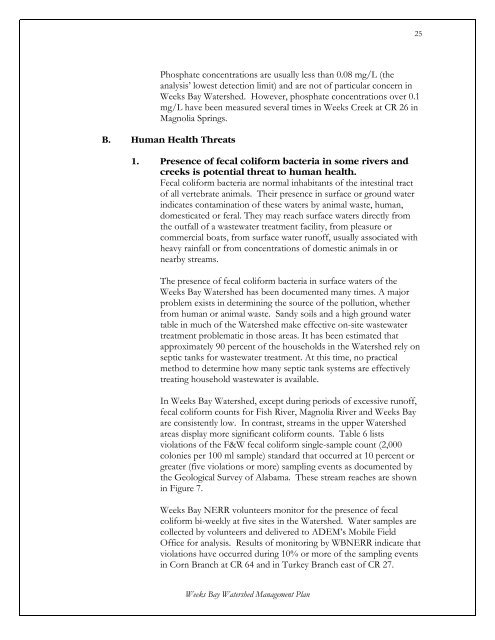Weeks Bay Watershed Project Management Plan - Mobile Bay ...
Weeks Bay Watershed Project Management Plan - Mobile Bay ...
Weeks Bay Watershed Project Management Plan - Mobile Bay ...
You also want an ePaper? Increase the reach of your titles
YUMPU automatically turns print PDFs into web optimized ePapers that Google loves.
25<br />
Phosphate concentrations are usually less than 0.08 mg/L (the<br />
analysis’ lowest detection limit) and are not of particular concern in<br />
<strong>Weeks</strong> <strong>Bay</strong> <strong>Watershed</strong>. However, phosphate concentrations over 0.1<br />
mg/L have been measured several times in <strong>Weeks</strong> Creek at CR 26 in<br />
Magnolia Springs.<br />
B. Human Health Threats<br />
1. Presence of fecal coliform bacteria in some rivers and<br />
creeks is potential threat to human health.<br />
Fecal coliform bacteria are normal inhabitants of the intestinal tract<br />
of all vertebrate animals. Their presence in surface or ground water<br />
indicates contamination of these waters by animal waste, human,<br />
domesticated or feral. They may reach surface waters directly from<br />
the outfall of a wastewater treatment facility, from pleasure or<br />
commercial boats, from surface water runoff, usually associated with<br />
heavy rainfall or from concentrations of domestic animals in or<br />
nearby streams.<br />
The presence of fecal coliform bacteria in surface waters of the<br />
<strong>Weeks</strong> <strong>Bay</strong> <strong>Watershed</strong> has been documented many times. A major<br />
problem exists in determining the source of the pollution, whether<br />
from human or animal waste. Sandy soils and a high ground water<br />
table in much of the <strong>Watershed</strong> make effective on-site wastewater<br />
treatment problematic in those areas. It has been estimated that<br />
approximately 90 percent of the households in the <strong>Watershed</strong> rely on<br />
septic tanks for wastewater treatment. At this time, no practical<br />
method to determine how many septic tank systems are effectively<br />
treating household wastewater is available.<br />
In <strong>Weeks</strong> <strong>Bay</strong> <strong>Watershed</strong>, except during periods of excessive runoff,<br />
fecal coliform counts for Fish River, Magnolia River and <strong>Weeks</strong> <strong>Bay</strong><br />
are consistently low. In contrast, streams in the upper <strong>Watershed</strong><br />
areas display more significant coliform counts. Table 6 lists<br />
violations of the F&W fecal coliform single-sample count (2,000<br />
colonies per 100 ml sample) standard that occurred at 10 percent or<br />
greater (five violations or more) sampling events as documented by<br />
the Geological Survey of Alabama. These stream reaches are shown<br />
in Figure 7.<br />
<strong>Weeks</strong> <strong>Bay</strong> NERR volunteers monitor for the presence of fecal<br />
coliform bi-weekly at five sites in the <strong>Watershed</strong>. Water samples are<br />
collected by volunteers and delivered to ADEM’s <strong>Mobile</strong> Field<br />
Office for analysis. Results of monitoring by WBNERR indicate that<br />
violations have occurred during 10% or more of the sampling events<br />
in Corn Branch at CR 64 and in Turkey Branch east of CR 27.<br />
<strong>Weeks</strong> <strong>Bay</strong> <strong>Watershed</strong> <strong>Management</strong> <strong>Plan</strong>
















